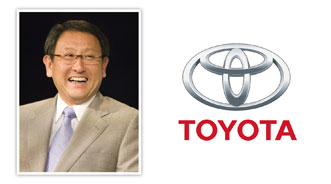In Connection with Global Vision, Toyota Announces Executive, Organizational Changes

At the same time the automaker unveiled its “Global Vision,” to serve as the corporate outline for the future, Toyota Motor Co. revealed significant changes Wednesday to its executive structure charged with carrying out that vision.
Effective April 1, Toyota chose to streamline its board of directors, reducing the amount down to 11 from 27. The automaker explained that the board of directors will be composed of the chairman, president, five executive vice presidents, and the four officers responsible for the business development group, accounting group and external affairs group.
Toyota indicated that a formal decision will be made at the board of directors gathering held after its upcoming 107th general shareholders meeting.
Along with streamlining the board of directors, Toyota also highlighted that it’s scaling down its executive decision-making system.
The company said the current three-tier executive system with executive vice presidents, chief officers and officers responsible for group affairs will be streamlined to two tiers by eliminating the officers responsible for group affairs.
Toyota noted chief officers will be appointed in a flexible manner from the new positions of senior managing officers or managing officers. The company added that the senior managing director position will be eliminated — with a formal decision made at the board of directors meeting held after the general shareholders meeting.
As a result of these changes, Toyota indicated there will also be a substantial reduction in the total number of executives from 77 to 60.
Continuing on with its management changes, Toyota plans to modify structures to allow local decision making by overseas affiliates
Officials explained regional chief officers will in principle be stationed in their respective regions and the number of executives stationed outside Japan will be increased from 13 to 15. They said divisions’ functions — which are presently performed in Japan — will be transferred overseas in stages.
Toyota said it’s making these changes to ensure outside opinions “are listened to in earnest and reflected in management practices.”
To reflect that sentiment, the automaker plans to establish regional advisory committees in North America, Europe and Asia. The company also intends to appoint Yoko Wake of Keio University to serve as an outside corporate auditor.
The final element of Toyota’s executive shake-up was the decision to alter the position of executive general manager to be a non-executive post.
“Executive general managers will be responsible for areas that require close contact with work sites and the implementation of management,” Toyota explained.
“Executive general managers will fill such posts as grand chief engineers responsible for vehicle development, general managers responsible for technology and plant general managers,” the company continued.
In articulating all of these management changes, Toyota emphasized the new structure is intended to meet three objectives:
—Convey customer opinions and on-site information to management in a timely manner.
—Make prompt management decisions based on on-site information.
—Make constant checks as to whether management decisions are acceptable to society.
A complete list of executives and their new roles is available here.
Toyota Unveils Global Vision
In conjunction with the management changes, Toyota rolled out its new global vision that comes with the moniker, “Rewarded with a smile by exceeding your expectations.”
Company leaders believe this strategy will not only to give direction to Toyota employees around the world, but also to convey such direction to customers and to the public at large.
“The global vision incorporates lessons TMC learned through the market downturn that followed the global financial crisis and through a series of product recalls,” company executives stressed.
“It outlines the ideal form the company should take in response to self-asked questions about what kind of organization TMC should be and what kind of values it should honor,” they continued. “TMC-related operations around the world will define their own missions in the context of fulfilling the mission statement and will translate those missions into concrete actions.”
Here is the text of the Toyota Global Vision:
“Toyota will lead the way to the future of mobility, enriching lives around the world with the safest and most responsible ways of moving people. Through our commitment to quality, constant innovation and respect for the planet, we aim to exceed expectations and be rewarded with a smile. We will meet challenging goals by engaging the talent and passion of people who believe there is always a better way.”
Automaker Establishes 2015 Global Initiatives
In connection with this vision, Toyota rattled off initiatives to be reached by 2015 in four different categories: product strategy, supply strategy, diversification and profitability.
With regard to product strategy, the automaker wants to “greatly improve the design and feel of Toyota models and make way for the leading role of localization in vehicle production.” Toyota intends to offer “genuinely exciting models that meet the needs of each market.”
In an attempt to minimize the environmental impact, Toyota is looking to expand its line of hybrid models, launching about 10 more by 2015. The company also is extending development of a full range of plug-in hybrid vehicles, pure electric vehicles and fuel cell units.
Turning specifically to Lexus, the automaker wants the nameplate to be “a truly global premium brand.” The company is determined to leverage what it sees as Lexus’ strengths in product quality, “emphasizing emotive ride, original design and advanced technology.”
The OEM intends to offer Lexus models in a growing range of emerging markets and expand the Lexus sales networks in markets where the brand is already a presence.
Toyota recapped that 60 percent of its 2010 sales came from industrialized nations while the remaining 40 percent derived from emerging markets. The company objective by 2015 is to have its sales come equally from those to areas.
Switching over to its supply strategy, Toyota explained that it wants to “make the most of its existing production capacity in Japan and its world-leading manufacturing expertise in manufacturing hybrid vehicles and other technologically advanced, high-value-added products.”
The company reiterated similar objectives for its facilities in North America and Europe.
Meanwhile, within emerging markets, the automaker is hoping to expand production capacity, analyzing demand prospects in each region carefully to determine the geographical positioning, the timing and the scale of investment in expanded capacity.
When looking at diversification, Toyota plans to participate in developing “smart communities,” in which vehicles will manifest new kinds of added value as part of integral linkages between vehicles, homes and information networks.
Toyota also wants to collaborate with world-leading information technology companies in deploying “smart centers” globally.
And when discussing profitability, Toyota’s global vision seeks to strengthen the three core functions of quality maximization — cost-minimization and human resources development in support of regional strategy, product strategy and business-sector strategy.
When achieved, Toyota thinks it can “shape a solid and lean business foundation by reconciling high quality with low cost.”
The company also wants to reinforce Toyota’s business foundation by working as soon as possible to achieve the goals of raising consolidated operating return on sales to 5 percent and of restoring the Japan-based parent company of the Toyota Group to profitability.
Furthermore, officials are looking to position Toyota as soon as possible to consistently achieve an annual operating return on sales of 5 percent — operating income of about 1 trillion yen at the company’s present sales volume — at a yen/dollar exchange rate of 85 yen to the dollar and at a unit sales volume of 7.5 million vehicles.
Toyota’s Role of Regional Operations
Turning back to the global vision and management objectives, Toyota said it’s positioning regional initiatives as a “driving force.”
Toyota intends to work through locally based operations to provide distinctive products and services tailored to needs and wants in each community and nation. The automaker believes it can achieve that objective through two processes:
—The global headquarters will provide overall direction and furnish support for initiatives undertaken by the regional operations.
—Regional operations —the company’s customer interface — will decide on their own how best to serve their customers.
Officials indicated regional operations will begin drawing up plans next month that will define their roles to play and issues to address in support of fulfilling the Toyota Global Vision and that will detail their regional mission and management strategies.
More Description of Global Vision
Toyota used eight phrases to elaborate about how its global vision is intended to be beneficial.
“Toyota will lead the way to the future of mobility, enriching lives around the world with the safest and most responsible ways of moving people,” company officials asserted.
“Through our commitment to quality, constant innovation and respect for the planet, we aim to exceed expectations and be rewarded with a smile,” they went on to say. “We will meet challenging goals by engaging the talent and passion of people, who believe there is always a better way.”
The first global vision description phrase Toyota offered was “the safest and most responsible ways of moving people.”
In stressing the point, officials emphasized “Toyota will also continue to contribute to environmental quality and to human happiness by leading advances in technologies for minimizing environmental impact and by deploying those technologies in a growing line of vehicle models. At the same time, the company will work through its products, sales and services to ensure a rewarding experience for customers.”
Next, Toyota believes its vision is “enriching lives around the world.”
Company executives think “Toyota has been consistently true to its founding spirit of serving society through conscientious manufacturing, and it will continue working in that spirit to enhance the quality of life wherever it has operations.
“Toyota will continue contributing to economic vitality wherever it has operations by generating stable employment and by participating in mutually beneficial business relationships with dealers and suppliers,” they continued. “It will also continue to engage actively in initiatives for nurturing human resources and for enhancing the cultural life of its host communities.”
As the OEM touched on earlier, Toyota is geared to “lead the way to the future of mobility.”
When discussion this element, officials declared “Toyota will lead industry in tackling technological advances that will spawn next-generation mobility. It will explore possibilities in personal mobility, for example, and in the convergence of information technology for automobiles and ‘smart grids’ for optimizing energy generation and consumption. Toyota will undertake such leading-edge R&D with an eye to adapting products and services to the needs and circumstances in each market.
“Toyota will develop low-carbon technologies and technologies for maximizing safety through interaction with the transport infrastructure to lay a foundation for sustainable and amenable future mobility,” they added. “The company will work in this and other ways to support new kinds of lifestyles, while propagating technologies for preserving environmental quality.”
Moving on with its eight vision phrases, Toyota executives reiterated their “commitment to quality, constant innovation”
To be specific, they said, “Toyota is committed to providing highly reliable quality that will enable people to feel good about driving and riding in its vehicles.
“Toyota will continue to reinvent itself and to develop technologies to address the needs of today and of tomorrow,” they went on to note. “That includes working to provide vehicles that meet people’s needs and that are affordable everywhere.”
In connection with “respect for the planet,” Toyota again pledged to minimize environmental impact in its manufacturing and other operations as well as in its products.
“Toyota’s activities will include conserving energy and reducing output of carbon dioxide, as well as conserving material resources through recycling,” the company highlighted. “It will also include establishing mindsets and production methods appropriate for coexistence with nature.”
In again stating to “exceed expectations and be rewarded with a smile,” the automaker emphasized that “everyone at Toyota will continuously maintain a sense of gratitude to customers and will strive to earn smiles with products and services that are stimulating and even inspiring.”
Toyota’s vision also includes the sentiment that “There is always a better way.”
To capture the point, executives indicated “all Toyota employees will share the recognition that there is always a better way and share a commitment to continuous improvement, which are fundamental to The Toyota Way.”
Finally, Toyota thinks it can achieve its vision by meeting “challenging goals by engaging the talent and passion of people.”
Toyota intends to “nurture a corporate culture where teamwork and individual creativity thrive and where people will approach their work with pride and with passion.
“The company will honor the spirit of diversity in recruiting, training and promoting capable individuals around the world,” officials continued. “Human resources development at Toyota will continue to promote the transmission of the company’s monozukuri spirit of conscientious manufacturing and related skills and know-how from one generation to the next.”
Toyota Visionary Management: The Tree Metaphor
To wrap up explaining its global vision, Toyota offered how it’s meant to be like a tree.
First off, officials said the vision has roots, which they believe are the shared values.
“The roots of the tree are shared values,” Toyota stated. “Those are the same basic values that people at Toyota have expressed over the years as the Toyoda Precepts, as the Toyota Guiding Principles, and as The Toyota Way. They are the spirit of conscientious manufacturing.”
Next, the automaker moved on to the fruit, which is making vehicles and contributing to host communities.
“The fruit yielded by the tree symbolize Toyota’s progress in creating ever-better vehicles and contributing to economic and social vitality in Toyota’s host communities,” the OEM emphasized.
“That progress will earn a welcome place for Toyota in communities around the world,” management added.
And the trunk, Toyota said represents a solid business structure.
“Business vitality is the trunk that supports Toyota’s activities toward creating products that will win customer smiles,” officials insisted. “In Toyota’s tree metaphor, solid business is the trunk of the tree. Through that trunk flows the nutrition for supple limbs, branches and leaves and for bounteous fruit.
“Toyota’s vision thus evokes a virtuous circle,” officials went on to say. “The company will contribute to its host communities by making excellent automobiles. Earning a welcome place for Toyota in its host communities will support sound returns. And Toyota will reinvest those returns in creating ever-better vehicles for customers and will achieve sustainable growth."
The automaker pointed out the Toyota Global Vision was compiled by a team headed by TMC president Akio Toyoda and included members drawn from the company’s operations around the world.
“All 300,000 of us at Toyota worldwide,” Toyoda declared, “will take part in laying a foundation for sustainable growth. Working side by side, we will strive to earn smiles by exceeding customers’ highest expectations. Together, we will write a new chapter of Toyota history.”

 View The Latest Edition
View The Latest Edition

